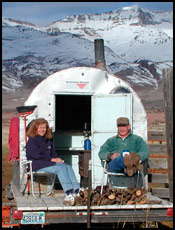
Ron Torell with his wife, Jackie.
Cow Camp Chatter
Total mixed rations
When I was a child, my mother served beef stew as an inexpensive means to feed her family of eight while forcing my siblings and me to unknowingly eat our vegetables. By combining beef, onions, potatoes, carrots, peas, corn and an occasional turnip in one pot, that stew was essentially a total mixed ration (TMR). Total cost was less than a quarter per head per day. Relative to a cow-calf operation, let's discuss how a TMR might work for you.
Recent cost increases for processed feeds have not lowered the nutritional requirement of the beef cow. Her requirements remain the same and must still be met.
Managers can reduce the dependency on processed feeds by matching the cow's nutritional needs to her environment through genetic improvement and by calving in harmony with mother nature. For those operations that rely on processed winter feed, chopping and blending ingredients into a mixed or TMR may be an option to consider. Cows can do very little sorting for preferential ingredients when all feedstuffs are chopped into small and similar-size particles, then blended together and served with a molasses gravy. This reduces and/or eliminates waste of the lower-quality ingredients in the ration.
We have all experienced the frustration of cows resisting and wasting lower-quality long hay in wait for more palatable, better-quality feedstuffs to arrive. Case in point is the common practice of feeding unprocessed quality alfalfa hay in combination with straw or lower-quality grass hay. On paper, a mixed ration of each may meet all of the cow's nutritional needs. With this, however, 'feedability' becomes an issue. The bully or boss cows clean up the alfalfa, leaving the straw or grass hay to the thinner, less aggressive cows.
The benefit of TMRs
Feeding beef cows a chopped or mixed ration generally does not fit many cow-calf operations, yet it is widely utilized by the feedlot and dairy industries. The real benefit of TMRs is the ability to cheapen the ration by utilizing a mix of both high- and lower-quality and -valued feeds. It is easy to balance the ration by weighing and blending all feedstuffs into a complete stew. With the use of grinders, mixers, scales and feed wagons, each bite contains small particle sizes of the required level of nutrients, such as energy, protein, minerals and vitamins. Additionally, cattle are fed in a bunk, which aids in minimizing waste and makes it easier for managers to monitor and adjust consumption and nutrient levels.
The key to success with TMRs is forage analysis of feedstuffs and grouping animals according to their individual nutrient demands. Once this information is known, a least-cost ration specific to that group of cattle can be formulated, feeding exact amounts of required nutrients for a specific production level.
TMRs are often dependent on access to byproduct feeds. Geographically, some areas of the United States have access to more byproduct feeds than others, lending themselves to the more economically viable use of TMRs. Many Midwest and Southern states have access to cornstalks, milo stubble, wet distillers' grain, onions and carrots. Other areas have potatoes, turnips, wheat straw, tomato peels and cannery waste.
Cautions
It's important to point out that there is the potential for toxins in some byproduct feeds, and the toxins could be fatal when consumed at high levels. On the other hand, when these same byproducts are fed in a TMR at low levels, they may not pose such a risk. Feed analysis reveals forage quality, while additional tests show if any toxins are present and at what level.
Managers must also take in to account that storage and transportation of high-moisture byproducts may not be economically viable for their operation.
Beef cows are often winter-fed on the ground in large fields of byproduct or aftermath standing forage. Wind and mud may become issues when trying to efficiently deliver TMRs to cows under these conditions. With the availability of modern machinery, a chopped or partially mixed ration may be worth considering.
Several commercial PTO-driven and portable hay grinders, choppers and feeders are now available to partially break down the feedstuffs by slicing, dicing or grinding, and deliver the feed either as a single or combination of ingredients. Much of this new equipment does not feed a TMR, but rather a chopped and blended buffet of various feed qualities. Anything that can be done to partially break down the feedstuff and make it more palatable and efficient for the rumen to digest is the main objective.
Feeding a chopped or blended ration is certainly not for every operation. Cost and economy of size will limit the use of commercial equipment to the larger enterprises that have the required cow numbers to absorb and spread out that initial investment. Savings in feed costs and efficiency may very well outweigh equipment cost for the larger operator.
The bovine was given a unique digestive system enabling her to eat and digest many different feedstuffs of both high and low qualities. Standing forage is generally the cheapest form to feed cows; however, it isn't always available in sufficient quality and quantity to meet a cow's total nutritional requirements. Figuring out the proper ration and delivering it in a palatable manner that entices cattle to consume the lower-quality feeds is the challenge.
That's enough for this month. A special thanks to my wife, Jackie, for her part in writing "Cow Camp Chatter." As always, if you would like to discuss this article or simply want to talk cows, do not hesitate to contact me at 775-385-7665 or e-mail me.











